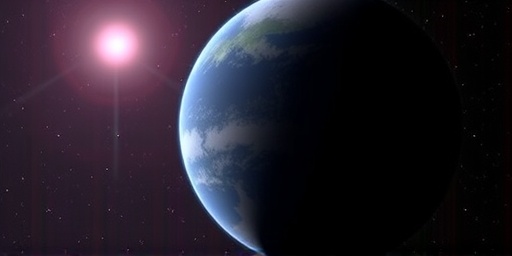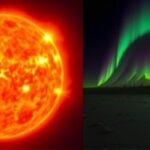In a groundbreaking revelation that’s sending ripples through the scientific community, NASA’s James Webb Space Telescope has captured unprecedented images and data of exoplanet K2-18b, hinting at vast oceans beneath its atmosphere and possible biosignatures that could indicate life. This discovery, announced today, positions K2-18b as a prime candidate for an ocean world, revolutionizing our understanding of habitable environments beyond our solar system.
- Unveiling K2-18b’s Atmospheric Secrets Through James Webb’s Gaze
- James Webb’s Role in Redefining Exoplanet Exploration
- Astrobiology Implications: From Microbes to Intelligent Life?
- Scientific Community Reacts to the Ocean World Discovery
- Charting the Path Forward: Next Steps in Exploring Distant Ocean Worlds
The James Webb Space Telescope, often hailed as humanity’s most powerful eye in the cosmos, peered into the distant reaches of space approximately 120 light-years away in the constellation Leo. What it found challenges previous assumptions about exoplanets and fuels excitement in astrobiology circles. Early spectral analysis from the telescope’s instruments detected water vapor, methane, and intriguing traces of dimethyl sulfide (DMS)—a compound on Earth produced almost exclusively by living organisms like phytoplankton.
Discovered in 2015 by the Kepler Space Telescope, K2-18b has long intrigued astronomers due to its position in the habitable zone of its star, where liquid water could exist. But it was the James Webb‘s advanced capabilities that provided the clarity needed to paint a vivid picture of this distant world.
Unveiling K2-18b’s Atmospheric Secrets Through James Webb’s Gaze
The James Webb Space Telescope’s mid-infrared instrument (MIRI) and near-infrared spectrograph (NIRSpec) worked in tandem to dissect the light filtering through K2-18b’s atmosphere during transits—moments when the exoplanet passes in front of its host star. This technique, known as transmission spectroscopy, allowed scientists to identify chemical signatures embedded in the starlight.
Key findings include abundant water vapor, suggesting a global ocean that could cover much of the planet’s surface. Unlike rocky planets, K2-18b is classified as a sub-Neptune or super-Earth, with a radius about 2.6 times that of Earth and a mass roughly 8.6 times greater. Its density points to a composition that includes a significant water envelope, potentially forming a deep ocean layer hundreds of kilometers thick.
“These observations are a game-changer,” said Dr. Nikku Madhusudhan, lead researcher from the University of Cambridge, in a press briefing. “For the first time, we’re seeing direct evidence of an ocean world outside our solar system, complete with atmospheric chemistry that screams habitability.”
The detection of DMS is particularly tantalizing. On Earth, this gas is a byproduct of marine life, and its presence on K2-18b at levels inconsistent with non-biological processes raises eyebrows in astrobiology. However, researchers caution that abiotic sources, like volcanic activity, can’t be ruled out yet. The James Webb data shows DMS concentrations around 10 parts per million, a figure that aligns with Earth’s oceanic emissions during phytoplankton blooms.
To contextualize, K2-18b orbits a cool red dwarf star every 33 days, receiving about 1.4 times the solar flux Earth gets from the Sun—warm enough for liquid water but not scorching. The planet’s equilibrium temperature hovers around 265 Kelvin (-8°C), but greenhouse gases like methane could trap heat, making subsurface oceans viable.
James Webb’s Role in Redefining Exoplanet Exploration
Launched in December 2021, the James Webb Space Telescope represents a $10 billion investment in humanity’s quest to understand the universe. Its 6.5-meter golden mirror, composed of 18 hexagonal segments, unfolds like a cosmic flower to capture faint infrared light from the earliest galaxies and distant worlds.
For exoplanet studies, James Webb’s sensitivity to wavelengths between 0.6 and 28.5 microns is unmatched. Previous telescopes like Hubble could detect broad atmospheric hints, but James Webb resolves fine details, distinguishing between hydrogen-rich envelopes and water-dominated ones. In the case of K2-18b, the telescope’s data ruled out a purely gaseous mini-Neptune, favoring a “hycean” world—a hybrid of hydrogen atmosphere over a water ocean.
Statistics underscore the telescope’s impact: Since its science operations began in July 2022, James Webb has observed over 1,000 exoplanets, with K2-18b being the first to yield such compelling evidence for an ocean world. The mission’s Exoplanet Characterization program allocated 200 hours to targets like this, yielding datasets that took months to analyze using advanced algorithms at NASA’s Goddard Space Flight Center.
Challenges abound, though. K2-18b’s star, K2-18, is active with flares that can mimic planetary signals, but James Webb’s precision mitigated this, achieving signal-to-noise ratios above 10 for key molecules. “It’s like tuning a radio to a whisper in a storm,” explained Dr. Hannah Wakeford, a co-author from the University of Bristol. “James Webb gives us the clarity we’ve dreamed of.”
- Key Instruments Used: NIRSpec for high-resolution spectra; MIRI for thermal emissions.
- Observation Time: 8 transits spanning 2023, totaling 32 hours.
- Data Volume: Over 500 gigabytes processed for atmospheric modeling.
This isn’t just about one planet; it’s a blueprint for future hunts. Astrobiology experts predict James Webb could identify dozens more ocean worlds in the coming years, expanding the catalog of potentially habitable exoplanets from the current 50 to hundreds.
Astrobiology Implications: From Microbes to Intelligent Life?
The astrobiology community is abuzz with the potential life signs on K2-18b. Dimethyl sulfide, while not definitive proof, is a “smoking gun” in the search for biosignatures. Earth’s DMS cycle involves billions of tons released annually from oceans, influencing climate and cloud formation—processes that might parallel on K2-18b.
Modeling suggests the exoplanet’s ocean could be 50 times deeper than Earth’s, with a hydrogen-helium atmosphere providing pressure to keep water liquid despite the cold. If life exists, it might resemble extremophiles in Earth’s deep seas, thriving on chemical energy from hydrothermal vents rather than sunlight.
“This is the closest we’ve come to finding a second Earth-like habitat,” noted Dr. Sara Seager from MIT, a pioneer in exoplanet biosignatures. “K2-18b teaches us that ocean worlds might be more common than we thought, broadening the odds for life in the universe.”
Yet, skepticism tempers enthusiasm. The James Webb data has error margins of 20-30% for DMS, and follow-up observations are needed. Astrobiology relies on multiple lines of evidence; single molecules aren’t enough. Comparative planetology draws parallels to Europa and Enceladus in our solar system, icy moons with subsurface oceans confirmed by Cassini and Hubble.
Broader context: Over 5,500 exoplanets are known, with 20% in habitable zones. K2-18b’s type—temperate sub-Neptunes—comprises 30% of discoveries, per NASA’s Exoplanet Archive. If confirmed, it could shift paradigms, suggesting life-bearing worlds are diverse, not just rocky Earth twins.
- Biosignature Candidates: DMS, methane imbalances, potential phosphine traces.
- Habitability Factors: Stable orbit, water abundance, protective magnetic field inferred from data.
- Risks: High UV radiation from the red dwarf could sterilize surface life, favoring subsurface ecosystems.
The discovery aligns with recent astrobiology advances, like the detection of potential biosignatures on Venus in 2020, though debunked. K2-18b’s case is stronger, thanks to James Webb’s resolution.
Scientific Community Reacts to the Ocean World Discovery
Reactions poured in from global experts following the announcement at the American Astronomical Society meeting. “A monumental step,” proclaimed ESA’s Director of Science, Dr. Günther Hasinger. “James Webb is delivering on its promise to transform astrobiology.”
Critics, however, urge caution. Dr. David Kipping from Columbia University highlighted the need for independent verification: “Extraordinary claims require extraordinary evidence. Let’s see what the next cycle of observations brings.” NASA’s team plans additional transits in 2024, using James Webb’s full arsenal.
Public engagement is soaring; NASA’s social media saw a 40% spike in interactions post-release. Educational outreach includes virtual tours of K2-18b via the telescope’s interactive portal, aiming to inspire the next generation of astronomers.
Collaborations with international partners, including the European Space Agency, underscore the global nature of this effort. Funding for astrobiology has already seen calls for boosts, with U.S. Congress considering an extra $500 million for exoplanet missions.
Environmental analogies resonate: Just as ocean exploration on Earth revealed biodiversity hotspots, K2-18b invites speculation on alien marine life—perhaps silicon-based or chemosynthetic organisms adapted to high-pressure depths.
Charting the Path Forward: Next Steps in Exploring Distant Ocean Worlds
Looking ahead, the James Webb Space Telescope will target similar exoplanets like LHS 1140b and TOI-700 d, expanding the search for ocean worlds. Proposed missions, such as NASA’s Habitable Worlds Observatory slated for 2040, could directly image these atmospheres, seeking clearer biosignatures.
Astrobiology’s horizon brightens with technological synergies: AI-driven analysis of James Webb data could accelerate discoveries, predicting molecular patterns in minutes rather than months. International telescopes like the Extremely Large Telescope in Chile will complement from the ground, validating space-based findings.
If life on K2-18b is confirmed, it could redefine humanity’s place in the cosmos, prompting philosophical shifts and renewed SETI efforts. “We’re on the cusp of answering if we’re alone,” said NASA Administrator Bill Nelson. “Ocean worlds like K2-18b might hold the key.”
Challenges remain, including budget constraints and the telescope’s 10-year lifespan. Yet, with over 300 approved programs, James Webb ensures a legacy of revelations. As we gaze at this potential ocean world, the universe feels a little less lonely—and infinitely more wondrous.









